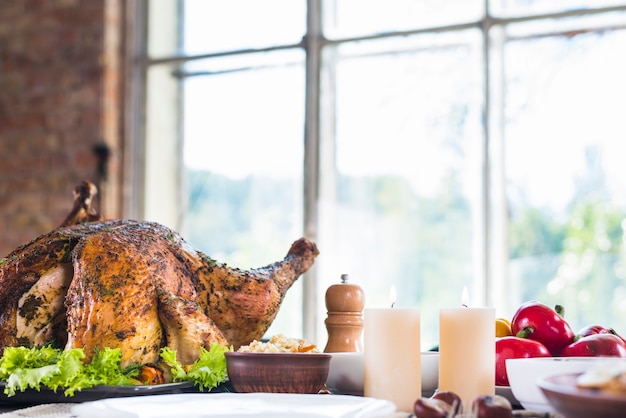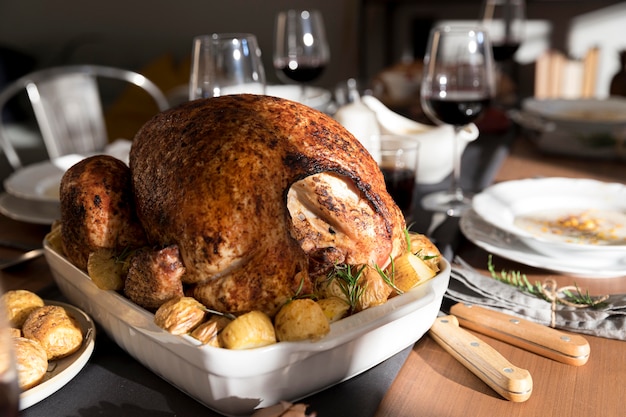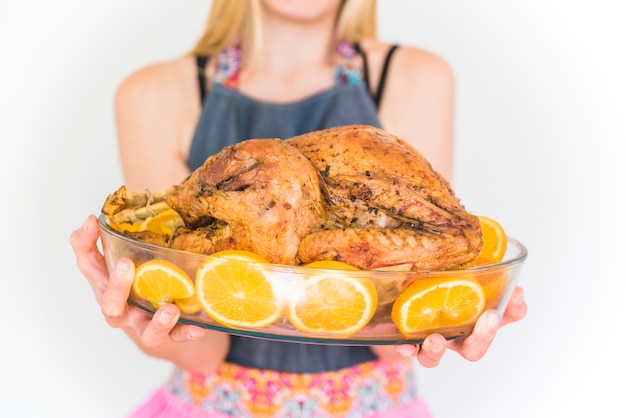Christmas is just around the corner, and you've got a magnificent 12-pound turkey perched on your kitchen counter, ready to be the star of your festive feast. But here's the thing - nobody wants a dry, overcooked turkey, and with a bird this size, getting the timing right can feel like a daunting task.
Don't worry, my fellow cooks! I've been there, and I'm here to share my hard-earned wisdom on mastering the art of turkey cooking. I've had my fair share of turkey-related disasters (I'm looking at you, 2017, when the bird turned into a brick), but I've also learned from my mistakes, and now, I can confidently say that I've got this whole turkey thing down pat.
This guide will break down the whole process, from prepping your turkey to calculating cooking times and ensuring a juicy, delicious outcome. So grab a cuppa, settle in, and let's get this turkey party started!
(Part 1) The Prep Work: Setting the Stage for Roast-tastic Success

Let's face it, you can't just chuck that turkey straight in the oven and expect a culinary masterpiece. A bit of prep is essential to ensure a delicious, moist bird.
1. Thaw That Bird: A Patience-Testing Process
If your turkey is frozen, it needs a good thaw before you can even think about roasting it. The rule of thumb is to thaw a 12-pound turkey in the refrigerator for about 3 to 4 days. This ensures a slow, safe thaw that prevents bacteria growth. A completely thawed bird should feel firm and have no ice crystals on the surface.
2. Pat it Dry: The Moisture Matters
Once your turkey is thawed, give it a good pat dry with paper towels. This helps to create a crispy skin, which is essential for a truly delicious roast. Trust me, nobody wants a soggy turkey skin.
3. Seasoning Game On: Flavour Explosion
This is where you can get creative! Seasoning your turkey is a crucial step to elevate its flavour. There are endless possibilities, but here are a few favourites:
- Classic Herb Rub: Salt, pepper, rosemary, thyme, sage – a timeless combo that never disappoints. A simple sprinkle of these herbs can really elevate the turkey's flavour profile.
- Citrus Burst: Lemon zest, orange zest, and a touch of garlic for a vibrant flavour. The citrus adds a bright and tangy element that cuts through the richness of the turkey.
- Spice It Up: A blend of paprika, cumin, chili powder, and garlic powder for a kick. For those who enjoy a bit of heat, this spice blend adds a wonderful depth of flavour to the turkey.
Remember, you can also add flavour through stuffing or by placing herbs and aromatics inside the cavity. Go wild, but don't overstuff the bird - it needs room to breathe and cook evenly.
(Part 2) Temperature Matters: A Crucial Factor for Success

Now, the temperature is a big deal when it comes to turkey cooking. You want to ensure even cooking and avoid any nasty surprises like undercooked meat.
1. The Oven Pre-Heat: A Temperature Tango
Always preheat your oven to 325°F (160°C) before you put the turkey in. This ensures that the oven is at the correct temperature when the bird goes in, leading to even cooking.
2. turkey temperature Check: The Proof is in the Puddings
To make sure your turkey is perfectly cooked, you'll need a meat thermometer. The goal is to reach an internal temperature of 165°F (74°C) in the thickest part of the thigh, without touching any bone.
Don't worry - it's easier than it sounds. Just insert the thermometer into the thickest part of the thigh, avoiding the bone, and read the temperature. If it's not at 165°F (74°C) yet, keep cooking until it reaches the desired temperature.
3. The Resting Game: A Time to Relax
Once your turkey reaches the desired temperature, take it out of the oven and let it rest for at least 20 minutes before carving. This allows the juices to redistribute throughout the meat, resulting in a succulent, juicy bird.
While the turkey rests, you can get the gravy ready. The juices that come out during the resting period are perfect for making a rich, flavourful gravy. Don't throw them away!
(Part 3) The Cooking Time: A Balancing Act

Now, let's talk about cooking time. This is where things can get a bit tricky, especially with a 12-pound turkey. You need to find the right balance between cooking time and ensuring the bird is cooked through and juicy.
1. The Rule of Thumb: A Rough Estimate
A good rule of thumb is to cook a 12-pound turkey for approximately 3-4 hours. However, this is just a rough estimate, and the actual cooking time can vary depending on the size of the bird, the oven temperature, and the method you are using.
2. The Doneness Check: No More Guesswork
The most reliable way to know if your turkey is cooked through is to use a meat thermometer. As mentioned before, the internal temperature should reach 165°F (74°C) in the thickest part of the thigh.
If you're unsure about the cooking time, it's always better to err on the side of caution and check the temperature regularly. You can use a timer to set reminders, or simply check it every 30 minutes.
3. Basting That Bird: A Moisture Boost
Basting your turkey with pan juices or butter can help to keep it moist during cooking. Basting involves spooning the juices over the turkey every 30-45 minutes. This helps to create a crispy skin and prevent the bird from drying out.
(Part 4) The Roasting Methods: Choosing Your Path
There are a few different roasting methods you can choose from, each with its own advantages and disadvantages. The method you choose will affect the cooking time and the overall flavour of the turkey.
1. Traditional Roasting: The Classic Approach
Traditional roasting involves placing the turkey in a preheated oven and cooking it at a moderate temperature. This is a straightforward method that results in a juicy and flavorful turkey.
2. The roasting pan Trick: Maximize Those Juices
If you're using a roasting pan, be sure to add a cup or two of water to the bottom of the pan before placing the turkey in. This will help to create steam and prevent the bird from drying out. Plus, you can use the pan juices to make delicious gravy.
3. The Roasting Rack: For That Crispy Skin
Using a roasting rack helps to create a crispy skin by allowing air to circulate around the turkey. Place the turkey on the rack, and then set the rack inside a roasting pan. This allows any juices to drip into the pan, resulting in a beautiful, golden-brown turkey with crisp skin.
(Part 5) Turkey Size and Cooking Time: A Chart to Guide You
Okay, let's get into the nitty-gritty - the relationship between turkey size and cooking time. It's not just about throwing a bird in the oven and hoping for the best. You need to consider the size of your turkey and adjust the cooking time accordingly.
Turkey Size and Cooking Time: A Handy Chart
Here's a table that can help you estimate the cooking time for your 12-pound turkey:
| turkey weight (pounds) | Cooking Time (hours) |
|---|---|
| 10-12 | 3-4 |
| 12-14 | 4-5 |
| 14-16 | 5-6 |
| 16-18 | 6-7 |
Remember, these are just estimates, and the actual cooking time may vary depending on your oven and the specific turkey. Always use a meat thermometer to ensure that the turkey is cooked through.
(Part 6) The Stuffing Dilemma: Bake it Separately
You might be tempted to stuff your turkey, but I highly recommend against it. The reason? Stuffing inside the turkey often doesn't reach a safe internal temperature of 165°F (74°C), potentially causing foodborne illness.
1. The Safer Stuffing Approach: Bake it Apart
The safest and most reliable way to cook stuffing is to bake it separately in a baking dish. This ensures that the stuffing reaches the desired temperature and is cooked evenly.
2. Stuffing Tips: Flavour and Safety
When making stuffing, use a good quality bread and add plenty of flavorful ingredients like herbs, vegetables, and broth. You can even add a bit of sausage or bacon for extra flavour.
Remember to bake the stuffing until it's cooked through and reaches an internal temperature of 165°F (74°C). You can use a meat thermometer to check the temperature.
(Part 7) The Leftover Magic: Transforming Turkey into Deliciousness
Once you've savored your turkey feast, don't let those delicious leftovers go to waste! There's a whole world of possibilities when it comes to transforming leftover turkey into new dishes.
1. turkey sandwiches: A Classic comfort food
Turkey sandwiches are a classic for a reason. Slice up the leftover turkey, add some mayo, lettuce, tomato, and cheese, and you've got yourself a satisfying and delicious lunch.
2. turkey soup: Warm and Comforting
Transform your turkey leftovers into a hearty and comforting soup. Use the leftover turkey meat, bones, and pan juices to create a rich and flavorful broth. Add vegetables like carrots, celery, and onions, and you've got yourself a soup that will warm you up on a chilly day.
3. turkey pot pie: A Savory Pie Delight
Combine your leftover turkey with a creamy sauce, vegetables, and a flaky crust to create a delicious pot pie. This dish is perfect for a family dinner or a potluck.
4. turkey salad: A Lighter Option
Mix up a simple and refreshing turkey salad with leftover turkey, mayonnaise, celery, onion, and herbs. Serve on bread, crackers, or lettuce leaves.
(Part 8) turkey cooking faqs: Your Questions Answered
Got questions about cooking your 12-pound turkey? I've got answers! Let's dive into some of the most frequently asked questions.
1. How long does it take to cook a 12-pound turkey?
As a general rule of thumb, a 12-pound turkey will take around 3-4 hours to cook. However, it's best to use a meat thermometer to ensure it's cooked through.
2. What temperature should a turkey be cooked to?
The recommended internal temperature for a turkey is 165°F (74°C) in the thickest part of the thigh.
3. Should I stuff the turkey?
It's safer to bake the stuffing separately to ensure it reaches a safe internal temperature.
4. How do I prevent the turkey from drying out?
Basting the turkey with pan juices or butter can help to keep it moist. You can also use a roasting rack to allow air to circulate around the bird.
5. How long should I let the turkey rest?
Let the turkey rest for at least 20 minutes after cooking to allow the juices to redistribute throughout the meat.
(Part 9) Additional Tips and Tricks
Here are a few additional tips and tricks to help you achieve turkey cooking success:
1. Brining: A Moisture Boost
Brining your turkey can help to keep it incredibly moist and tender. Brining involves soaking the turkey in a salt water solution for several hours. This process helps to draw moisture into the meat, resulting in a juicier and more flavorful bird.
2. Butter Up: Skin-Crisping Technique
For a truly crispy turkey skin, butter up the bird before roasting. You can also use a dry rub to help create a crispy crust.
3. Oven Placement: A Matter of Heat
Place the turkey in the center of the oven to ensure even cooking.
4. Avoid Overcrowding: Room to Breathe
Don't overcrowd the oven with other dishes. The turkey needs space to cook evenly.
(Part 10) The Final Word
And there you have it! A comprehensive guide to cooking a 12-pound turkey, from prep to cooking to leftover magic. Remember, the key to a successful turkey is preparation, patience, and a touch of culinary confidence. So, get your turkey ready, gather your loved ones, and enjoy a delicious and memorable feast! Happy holidays!
Everyone is watching

Corn on the Cob: The Ultimate Guide to Perfectly Cooked Ears
Healthy MealsAh, corn on the cob. Just the name evokes images of sunny days, barbecues, and that sweet, juicy flavour that ...

Perfect Pork Roast Oven Cooking Time: A Guide to Delicious Results
Healthy MealsThere's something truly satisfying about a perfectly roasted pork. The aroma alone is enough to make your mout...

Ham Cooking Time: How Long to Bake, Smoke, or Boil a Delicious Ham
Healthy MealsAh, ham. It's a classic, isn't it? A real crowd-pleaser, especially around holidays. And when done right, it'...

Scallops: The Ultimate Guide to Perfect Cooking
Healthy MealsAh, scallops. Those delicate, sweet, and utterly delicious morsels of the sea. They hold a special place in my...

Spaghetti Squash: The Ultimate Guide to Cooking and Serving
Healthy MealsRemember that time you saw spaghetti squash at the supermarket, looking all bumpy and strange, and thought, "W...
